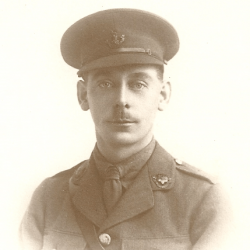George William Handforth was born in Ashton-under-Lyne on January 1, 1886 to Robert Handforth, a rent and debt collector, and Jane Alexandrina Handforth (née Dobie). George was educated at the Parish Church School but by the age of 15 had left school and was working as a solicitor’s clerk.
On April 18, 1902 he joined the 3rd Volunteer Battalion, the Manchester Regiment as a private. He was promoted to Corporal on January 29, 1907 and maintained his rank and seniority when the 9th Battalion Manchester Regiment, Territorial Force was formed on April 1, 1908 and was given service number 14. On December 1, 1909 he was promoted to Sergeant.
In his civilian life, by 1911 he was working as a clerk in the Ashton-under-Lyne Education Office and living with his widowed mother and his two younger sisters, Edith, a teacher, and Margaret who was still at school.
Based upon the recommendation of the battalion’s commanding officer he was commissioned into the 9th Battalion Manchester Regiment as 2nd Lieutenant on June 28, 1913, and promoted to Lieutenant on January 24, 1914 after passing the necessary exam.
He sailed with the battalion to Egypt and served with them through their training and preparations for action. He landed with the Battalion in Gallipoli on May 9, 1915 assigned to B Company. He took over command of C Company in June 1915 after their terrible losses that month and was officially appointed temporary Captain on June 18, 1915 in recognition of this new responsibility. He was involved in the battle of Krithia Vineyard in August, commanding 100 men of C and D companies. Later that month he reported sick to hospital after suffering from ill health for some time. He was sufficiently recovered by September 9th to take command of 102 men going to the light training camp at Imbros. Nevertheless, he reported sick to Hospital in Lemnos 10 days later, (and relinquished his temporary rank of Captain). He spent 21 days in Hospital in Malta before being invalided to the UK on October 8, 1915. Back in the UK he was awarded two months sick leave which was extended by an additional month in December, finally being passed fit for general service in January 1916.
The next official mention of him is rejoining the Battalion in Egypt, from the UK, on March 23, 1916 where he was once again awarded the temporary rank of Captain. The battalion war diary provides no mention of his activities but he was later to be mentioned in the despatch of July 17 by General Sir Archibald Murray for his distinguished services in the Sinai with the Desert Column. He sailed with the Battalion to France in March 1917 and in August 1917 he was promoted to Captain with precedence from June 1, 1916.
In France, he attended a course of instruction for Company Commanders at Flixecourt in April before proceeding to the UK for 11 days home leave, rejoining the Battalion in France on May 5, 1917. On June 26 he attended a school of instruction with the 3rd Army, rejoining the Battalion on August 2, 1917 after 37 days. He then spent almost two weeks sick in hospital from September 23rd to October 5th. 10 days after rejoining the Battalion he proceeded to leave in the UK for 12 days, returning on October 27, 1917. On February 20, 1918 he was transferred to the 1/7th Manchester Regiment and was struck off the strength of the Battalion. He remained in France until he was demobilised on August 27, 1919.
After the war he became a Freemason and was initiated into the Fidelity Lodge at Ashton-under-Lyne on May 18, 1919. Also members of this lodge were Frederick Arthur Makin and Robert Gartside Wood, who had joined in 1915 and 1917 respectively. He also studied and received a BA from London University.
Orders to reform the regiment were received in October 1920 and Lt-Col D. H. Wade was appointed Commanding Officer. A few weeks later the War Office confirmed the re-appointments of some old officers including Captain Handforth. He remained in the Territorials and on October 31, 1920 was awarded the Territorial Decoration for long service whilst holding the rank of provisional Major. He was confirmed in his rank of Major on January 27, 1925.
On January 28, 1926 he assumed command of the battalion, when Lt-Col. John Broadbent retired, and was simultaneously promoted to Lieutenant-Colonel. Four years later he was appointed Brevet Colonel and promoted to full Colonel on January 28, 1932 when he relinquished command of the battalion.
In April 1932 he married Dorothy Kershaw in Ashton-under-Lyne and on November 5th of the following year their first daughter, Pauline was born. Their second daughter, Susan Handforth was born in 1935.
By 1939 he was the Director of Education for Ashton and living on Mellor Road with his wife, two children and a domestic servant. During World War II he rejoined the service, finally retiring from the Territorial Army on January 1, 1943 and retaining the rank of Colonel. He was made a Deputy Lieutenant of the County Palatine of Lancaster on January 15, 1946.
Colonel George William Handforth, T.D. died on May 22, 1955. He was 69 years old.

